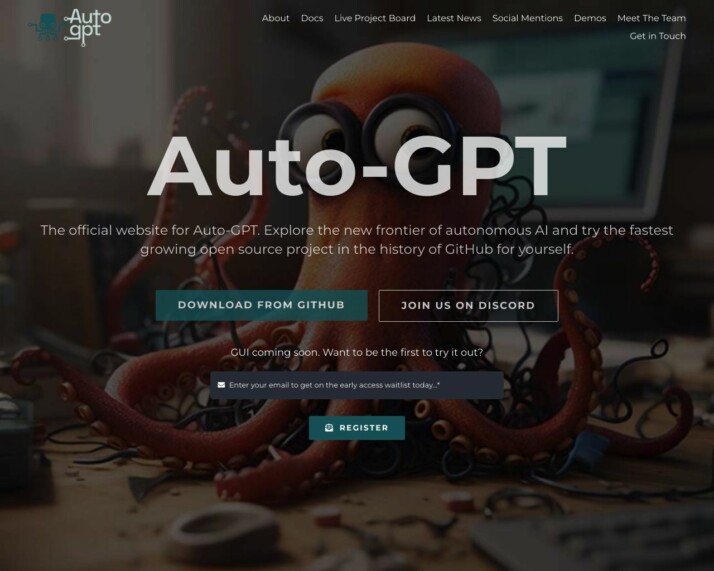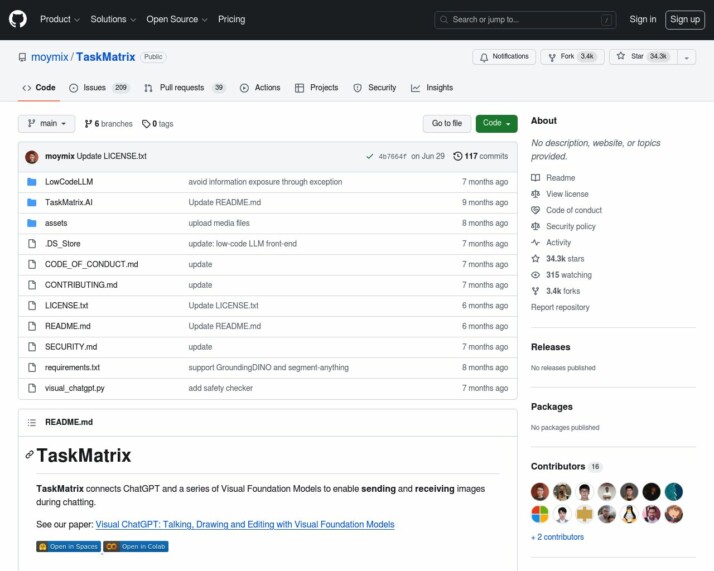Table of Contents
Introduction
Are you struggling to choose the right AI platform for your business needs? Look no further, as we bring you a comprehensive comparison between AutoGPT vs TaskMatrix.
With the rise of AI technology, it’s crucial to find the perfect tool that aligns with your specific requirements. In this article, we’ll dive into the features, functionalities, and unique aspects of these two AI platforms, helping you make an informed decision.
AutoGPT, powered by OpenAI’s advanced GPT models, offers a range of cutting-edge AI capabilities. On the other hand, TaskMatrix stands out with its multimodal conversational foundation model and emphasis on explainability and transparency. But which one is the right fit for you?
Let’s explore each platform in detail and discover the strengths and weaknesses they bring to the table.
An Introduction to AutoGPT: An Overview of its Offerings and Vision
Welcome to the world of AutoGPT, a sophisticated AI-based solution designed with cutting-edge GPT models. AutoGPT is a tool that primarily caters to technically proficient entities, such as research institutions, tech startups, and software developers, firmly placing itself at the forefront of AI innovation.


The unique selling points of AutoGPT rest in its autonomous functionality and its ability to execute complex tasks. Furthermore, it offers multimodal capabilities, handling different types of data inputs like text and images. It breaks tasks down into sub-tasks, allowing the user to tackle complex challenges with ease. Moreover, AutoGPT provides detailed logs for activities which assists with troubleshooting and further enhancing transparency.
One of the recent releases from AutoGPT is BabyAGI. This innovative AI-driven tool is designed for autonomous task generation and carries out the execution based on the user-set objectives. Packed with advanced AI technologies, BabyAGI can understand and solve complex tasks, reducing the cognitive load on users and allowing them to focus on more creative tasks.
Keeping in line with its future vision, AutoGPT is committed to staying updated with top-tier AI models, ensuring it provides versatile and efficient AI solutions. With an emphasis on problem-solving and autonomous functionality, AutoGPT aims to create advanced AI tools that cater to a wide array of applications, helping its users stay ahead in the rapidly evolving field of AI.
However, it is essential to note that while AutoGPT is deployable in environments like Docker, there’s no indication of it offering a cloud-hosted SaaS model. Memory and context are partially maintained, with short-term memory for the current task but no explicit mention of persistent cross-session memory.
On the whole, AutoGPT stays true to its mission to offer advanced AI tools, designed for a target audience that seeks to leverage AI for complex, innovative applications, making it a vital player in the AI tech sphere.
Introducing TaskMatrix: A Revolutionary AI Platform
Ever wondered about an all-in-one platform that can perform a range of tasks across different domains? Then TaskMatrix is your answer. This innovative AI platform offers a taste of the future with its distinctive features and forward-thinking vision.


At the core of TaskMatrix is the Multimodal Conversational Foundation Model (MCFM). This advanced mechanism comprehends user instructions in various formats and generates executable codes based on a broad collection of APIs. Its use of reinforcement learning with human feedback (RLHF) for optimizing models sets it apart in the realm of AI.
This platform is not only about automation and task completion. It also emphasizes explainability and transparency by providing feedback mechanisms for API developers. This feature assists in refining AI interactions and improving user experiences.
When it comes to the breadth of tasks that TaskMatrix can handle, the list is impressively long. The platform can expedite office automation, simplify cloud services utilization, as well as control robotics and IoT devices! To top it all off, you can operate it through voice commands!
So who can benefit from this platform? The target audience is diverse. Developers and engineers, business professionals, office workers, product managers, innovators, IoT and robotics enthusiasts, educators, researchers, and even general users seeking personalized AI assistance can find value in TaskMatrix.
Want to know the company’s future vision? TaskMatrix aims to create an AI system that can seamlessly interact with both digital and physical worlds. The ambition to integrate AI deeply into everyday tasks, both online and offline, makes TaskMatrix a feature-rich, forward-thinking player in the AI space.
With its most recent product releases, TaskMatrix has delivered a powerful AI platform capable of automating complex operations in software like PowerPoint, interacting with cloud services, and controlling physical devices. Truly a step into the future of AI!
A Detailed Feature Comparison of AutoGPT and TaskMatrix for Business Needs
In the ever-expanding world of AI software, two platforms stand out – AutoGPT and TaskMatrix. They both offer unique features that help automate business processes and meet different business needs. But their feature set differs – and understanding these differences is key to knowing which platform is right for you. Let’s dive deeper into the specific features of AutoGPT and TaskMatrix.
| Features | AutoGPT | TaskMatrix | SmythOS |
|---|---|---|---|
| Hosted Agents (Dev, Production) | ❌ | ✅ | ✅ |
| Environments (Dev, Production) | ✅ | ✅ | ✅ |
| Visual Builder | ❌ | ❌ | ✅ |
| No-Code Editor | ❌ | ❌ | ✅ |
| Memory & Context | ✅ | ✅ | ✅ |
| Autonomous Agents | ✅ | ✅ | ✅ |
| Explainability and Transparency | ❌ | ✅ | ✅ |
| Debug Mode | ❌ | ✅ | ✅ |
| Multimodal | ❌ | ✅ | ✅ |
| Problem-Solving Capabilities | ✅ | ✅ | ✅ |
The feature differences highlighted above matter in making an informed choice. For instance, the lack of a Visual Builder and No-Code Editor in AutoGPT may affect its usability for businesses that lack technical expertise. In contrast, TaskMatrix’s Explainability and Transparency feature offers an easy way for businesses to understand how decisions are made, boosting user confidence. Furthermore, TaskMatrix’s Debug Mode can drastically cut down development time, a critical factor for businesses that need to move fast.
For businesses that require multi-modal interactions, TaskMatrix offers an edge over AutoGPT. It means businesses can engage with their users in more interactive and engaging ways. No matter the unique offerings and business needs, picking the right tool is crucial to driving a positive impact on your business.
AutoGPT vs TaskMatrix: Target Audience Analysis
In this section, we will examine the intended audience for both AutoGPT and TaskMatrix. We will explore the end users, the specific features and applications catered to by each company, and identify which product aligns better with different user segments.
AutoGPT
The intended audience for AutoGPT appears to be organizations and developers who require advanced AI capabilities, particularly in the realms of language processing and image handling. The features and applications of AutoGPT cater to the following groups:
- Developers and Engineers: Given its reliance on coding and environment setup, AutoGPT is well-suited for those with a technical background in software development.
- Businesses Implementing AI Solutions: Companies looking to integrate sophisticated AI functionalities into their operations would find AutoGPT valuable. Its capabilities in handling complex tasks autonomously make it suitable for businesses seeking to enhance efficiency and automate processes.
TaskMatrix
The intended audience for TaskMatrix.AI spans several groups, catering to a diverse range of users with its comprehensive and multimodal AI functionalities:
- Developers and Engineers: With its API-centric architecture, TaskMatrix.AI is highly suitable for developers and engineers who need to integrate complex AI functionalities into their applications. The platform’s ability to handle a multitude of APIs and its emphasis on user feedback for improving API performance make it particularly appealing to this group.
- Business Professionals and Office Workers: The platform’s capabilities in automating tasks in software like PowerPoint and interfacing with cloud services suggest that it is well-suited for professionals in a business environment. It can significantly reduce the workload in accomplishing complex goals and adapting to new software updates, making it a valuable tool for office automation.
Based on the analysis, both AutoGPT and TaskMatrix.ai cater to different user segments and offer unique features and applications. However, in comparison to SmythOS, it is clear that SmythOS stands out as the favored choice due to its robust features and superior capabilities in software development and automation.
Conclusion
In conclusion, after comparing AutoGPT and TaskMatrix, it is evident that AutoGPT offers a sophisticated AI solution primarily built upon OpenAI’s GPT-4 or GPT-3.5 models. AutoGPT stands out for its integration with advanced GPT models, supporting various types of data inputs, and its autonomous functionality in performing tasks.
AutoGPT’s problem-solving skills and detailed audit logs contribute to its advanced problem-solving capabilities and transparency. The ability to deploy AI agents as APIs and its use of open-source components like Docker demonstrate a commitment to accessible and flexible technology.
With its capabilities in language processing and image handling, AutoGPT caters to a user base that is technically proficient and seeks to leverage AI for complex and innovative applications. This includes developers, tech-savvy businesses, research institutions, and organizations needing custom AI solutions.
While AutoGPT and TaskMatrix offer several impressive features, it is important to note that SmythOS provides even greater advantages. With its advanced natural language understanding and comprehensive AI capabilities, SmythOS excels in delivering accurate and efficient results. Additionally, SmythOS offers a user-friendly interface and seamless integration with various platforms, making it the preferred choice for businesses and developers.
Last updated:
Disclaimer: The information presented in this article is for general informational purposes only and is provided as is. While we strive to keep the content up-to-date and accurate, we make no representations or warranties of any kind, express or implied, about the completeness, accuracy, reliability, suitability, or availability of the information contained in this article.
Any reliance you place on such information is strictly at your own risk. We reserve the right to make additions, deletions, or modifications to the contents of this article at any time without prior notice.
In no event will we be liable for any loss or damage including without limitation, indirect or consequential loss or damage, or any loss or damage whatsoever arising from loss of data, profits, or any other loss not specified herein arising out of, or in connection with, the use of this article.
Despite our best efforts, this article may contain oversights, errors, or omissions. If you notice any inaccuracies or have concerns about the content, please report them through our content feedback form. Your input helps us maintain the quality and reliability of our information.
Alexander De Ridder
Co-Founder, Visionary, and CTO at SmythOS. Alexander crafts AI tools and solutions for enterprises and the web. He is a smart creative, a builder of amazing things. He loves to study “how” and “why” humans and AI make decisions.
Explore All Comparison Articles
Decisions vs. Sola: AI Workflow Automation Showdown
AI-powered workflow automation platforms revolutionize how businesses streamline operations and boost productivity. This comparison explores Decisions vs. Sola, and SmythOS,…
DeepOpinion vs. Sola: Comparing AI Automation Platforms
AI-powered automation platforms revolutionize business operations, but choosing the right solution can be challenging. This comparison of DeepOpinion vs. Sola,…
DevGPT vs. Sola: AI-Powered Development Tools Compared
AI-powered development tools revolutionize software creation, offering unprecedented efficiency and capabilities. This comprehensive review compares DevGPT vs. Sola, and SmythOS,…
Fine AI vs. Sola: Comparing AI Automation Tools
AI-powered automation transforms software development and business workflows, offering unprecedented efficiency and innovation. Fine AI vs. Sola present distinct approaches…
FlowiseAI vs. Sola: Comparing AI Automation Platforms
AI-powered automation revolutionizes business operations, driving efficiency and innovation across industries. FlowiseAI vs. Sola offer distinct approaches to harness this…
Gooey AI vs. Sola: AI-Powered Automation Platforms Compared
AI-powered automation platforms revolutionize how businesses streamline operations and enhance productivity. This comparison delves into Gooey AI vs. Sola, two…

